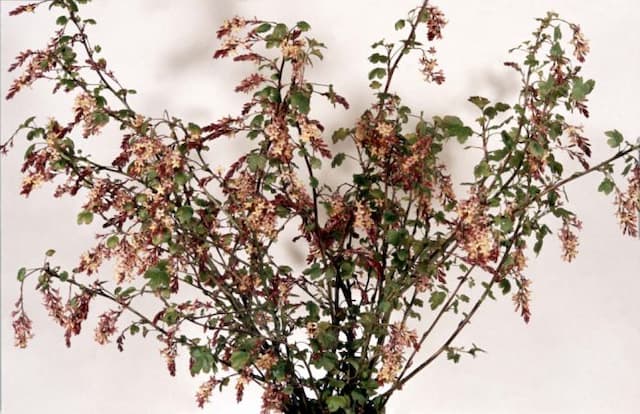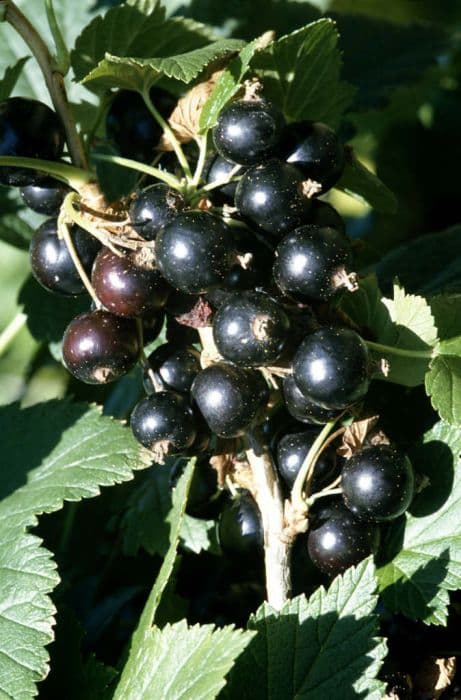Flowering Currant Ribes sanguineum 'Brocklebankii'

ABOUT
Ribes sanguineum 'Brocklebankii', commonly known as the golden flowering currant, is an ornamental shrub known for its striking foliage and beautiful blossoms. The leaves of this plant are particularly noteworthy, with a delicate, lobed appearance that takes on a charming golden-yellow color, which can add a bright spot of color to a garden setting. As the seasons change, the foliage may transition to include hints of pink or softer yellows, offering a dynamic display throughout its growing period. The flowers, appearing in clusters, are a vivid pink hue, and they dangle gracefully from the stems, resembling soft, cascading tassels. Each individual flower is tubular and small, and together they create an attractive contrast against the golden leaves. The blooming period is usually in the springtime, where it provides an early source of nectar for pollinators such as bees and hummingbirds. Over time, the flowers may give way to berries that start green and ripen to a dark hue, which can attract birds and other wildlife to the garden. Overall, the golden flowering currant presents a lovely, multi-faceted spectacle with its golden foliage and pink flowers, making it a pleasing addition to various garden designs and landscapes.
About this plant
 Names
NamesFamily
Grossulariaceae
Synonyms
Flowering Currant, Pink-Flowered Currant, Blood Currant, Winter Currant, Brocklebankii Golden Currant
Common names
Ribes sanguineum 'Brocklebankii'.
 Toxicity
ToxicityTo humans
The Flowering Currant (Ribes sanguineum 'Brocklebankii') is not known to be highly toxic to humans. However, consuming parts of the plant, particularly the fruit, may cause mild gastrointestinal upset in some individuals, as is common with many ornamental plants. Symptoms are typically not severe and might include nausea, vomiting, or diarrhea if ingested in large quantities. Always exercise caution and prevent children from ingesting plant material.
To pets
The Flowering Currant (Ribes sanguineum 'Brocklebankii') is generally considered to have low toxicity to pets. Ingesting parts of the plant may lead to mild gastrointestinal distress for animals, similar to humans. Symptoms could include vomiting or diarrhea if your pet eats a large amount of the plant. It is advisable to keep an eye on your pets and discourage them from chewing on the plant to prevent any potential discomfort.
 Characteristics
CharacteristicsLife cycle
Perennials
Foliage type
Deciduous
Color of leaves
Green
Flower color
Pink
Height
4-6 feet (1.2-1.8 meters)
Spread
4-6 feet (1.2-1.8 meters)
Plant type
Shrub
Hardiness zones
6
Native area
North America
Benefits
 General Benefits
General Benefits- Aesthetic Appeal: The Ribes sanguineum 'Brocklebankii', commonly known as 'Brocklebankii' flowering currant, has attractive pinkish-red flowers that enhance garden aesthetics, especially in spring when they bloom profusely.
- Wildlife Attraction: The plant serves as a food source for bees, butterflies, and birds, particularly hummingbirds, which are drawn to its nectar-rich flowers.
- Low Maintenance: It requires minimal care once established, needing only regular watering and occasional pruning to maintain shape.
- Drought Tolerance: Once established, 'Brocklebankii' flowering currant is relatively drought-tolerant, making it suitable for xeriscaping or gardens in drier climates.
- Seasonal Interest: It provides year-round interest with its flowers in the spring, berries in the summer, and sometimes colorful leaves in the fall.
- Privacy Screen: When planted in a row or as a hedge, it can create a decorative screen that offers a degree of privacy during the growing season.
- Naturalization: The plant can be used in naturalistic plantings and to stabilize slopes, fitting well into woodland gardens and native plant areas.
 Medical Properties
Medical PropertiesThis plant is not used for medical purposes.
 Air-purifying Qualities
Air-purifying QualitiesThis plant is not specifically known for air purifying qualities.
 Other Uses
Other Uses- Dye Production: The berries of Red Flowering Currant can be used to produce a natural dye for textiles, imparting a soft, greenish hue.
- Photography: Red Flowering Currant's vibrant flowers offer a picturesque subject for photographers, particularly as a symbol of spring in botanical and garden photography.
- Handicrafts: The plant's branches may be incorporated into wreaths and other decorative items, bringing a natural, woodsy element to crafts.
- Wildlife Garden: Planting Red Flowering Currant can create an attractive habitat for birds, which are drawn to the plant's berries.
- Soil Erosion Control: The plant can be used on slopes and banks for soil stabilization, helping to prevent erosion with its root system.
- Winter Garden Interest: With its colorful bark and persistent berries, Red Flowering Currant adds visual interest to winter gardens when most other plants are dormant.
- Educational Tool: The plant can be used in educational settings, such as school gardens, to teach students about native plant species and their ecological roles.
- Culinary Experiments: Though not commonly used for eating, the berries can be experimented with in the kitchen, possibly for making syrups or flavoring beverages in small quantities.
- Floral Arrangements: The flower clusters can be used in cut floral arrangements, providing a splash of color indoors during the blooming season.
- Nature-Inspired Art: The plant's form and color can inspire artists, serving as a subject for paintings, drawings, and other art forms that capture botanical beauty.
Interesting Facts
 Feng Shui
Feng ShuiThe flowering currant is not used in Feng Shui practice.
 Zodiac Sign Compitability
Zodiac Sign CompitabilityThe flowering currant is not used in astrology practice.
 Plant Symbolism
Plant Symbolism- Passion: The intense color of the flowers is often associated with strong emotions and passion.
- Renewal: As a plant that blooms in the spring, it is seen as a symbol of new beginnings and rejuvenation.
- Balance: Being a garden plant that is both ornamental and natural in appearance, it represents a harmonious balance between cultivated and wild beauty.
- Attraction: The striking flowers are known to attract hummingbirds, symbolizing allure and the ability to draw others toward oneself.
 Water
WaterThe flowering currant, commonly known as Ribes sanguineum 'Brocklebankii', prefers consistent moisture, especially during its growing season in the spring and summer. Water the plant deeply once a week, allowing water to penetrate the soil to a depth of at least 6 inches. This may equate to about 1 to 1.5 gallons per watering session, depending on soil type and weather conditions. During the hotter, drier months, monitor the soil moisture and water additionally if the top 2 inches of soil feel dry. In the winter, reduce watering frequency as the plant enters dormancy and its water needs decrease.
 Light
LightFor the flowering currant, or Ribes sanguineum 'Brocklebankii', the best light conditions involve a spot with full sun to partial shade. Ideally, it should receive at least 4 hours of direct sunlight daily for optimal flowering. Avoid deep shade locations, as this can reduce the vibrancy and abundance of its blooms.
 Temperature
TemperatureThe flowering currant, also known as Ribes sanguineum 'Brocklebankii', thrives in a temperature range between 60°F and 75°F which is ideal for its growth. It can tolerate a minimum temperature down to around 20°F and can survive maximum temperatures of about 85°F, but it is best to protect it from extreme temperature fluctuations.
 Pruning
PruningPrune the flowering currant, Ribes sanguineum 'Brocklebankii', to maintain shape and promote healthier, more vigorous growth. Cut back old wood right after flowering to encourage new growth, which will produce next year's blooms. Thin out crowded branches to improve air circulation. The best time for pruning is late spring or early summer, immediately after the blooms have faded.
 Cleaning
CleaningAs needed
 Soil
SoilFlowering Currant prefers well-draining soil enriched with organic matter, such as compost or aged manure. A slightly acidic to neutral pH of 6.0 to 7.0 is ideal for this plant. Amend heavy clay or sandy soils with organic matter to improve soil structure and water retention.
 Repotting
RepottingFlowering Currant, being a shrub, is generally not repotted as it's often planted directly in the garden. If grown in a container, repot every 2-3 years or when roots become crowded.
 Humidity & Misting
Humidity & MistingFlowering Currant thrives in average garden humidity levels. It is not particularly sensitive to humidity and can tolerate the variable conditions found in most garden environments.
 Suitable locations
Suitable locationsIndoor
Ensure bright, indirect light and cool temperatures for the Flowering Currant.
Outdoor
Plant in partial shade, amend soil with compost, water regularly for Flowering Currant.
Hardiness zone
6-8 USDA
 Life cycle
Life cycleThe life of Ribes sanguineum 'Brocklebankii', commonly known as the Golden Currant or Flowering Currant, begins with seed germination, which depends on a period of cold stratification to break dormancy. After sprouting, the seedling stage involves the development of a fleshy stem and true leaves, establishing the plant's initial root system. It then enters a juvenile vegetative stage, where it undergoes growth and branching to form the characteristic arching shrub structure. As the plant matures, it enters the flowering and reproductive stage, typically in early spring, producing cascades of pinkish-red flowers that attract pollinators and can lead to fruit set if conditions are favorable. The fruits, which are berries, mature in summer to a blue-black color, providing food for birds and wildlife, and contain seeds that can disperse to propagate new plants. Over many years, the plant will continue to grow and produce flowers and fruit annually, eventually reaching senescence, where growth slows, and the plant may die back or require rejuvenation through pruning.
 Propogation
PropogationPropogation time
Spring
The most popular method of propagating the Flowering Currant 'Brocklebankii' is through softwood cuttings. To successfully propagate, take softwood cuttings in late spring or early summer when the plant's new growth is just beginning to harden but is still flexible. Cut a 4- to 6-inch length (approximately 10 to 15 centimeters) from a healthy stem, ensuring that at least three sets of leaves are present. Remove the leaves from the lower half of the cutting, dip the cut end in rooting hormone powder, and then insert it into a soil-less potting mix. Keep the cutting in a humid environment with consistent moisture and indirect sunlight. Roots typically develop in a few weeks, after which the cutting can be transplanted to a larger container or a prepared garden bed.








